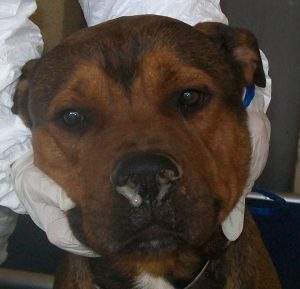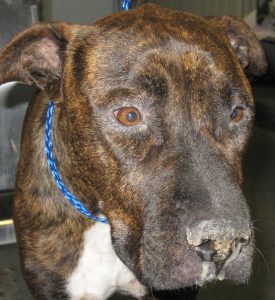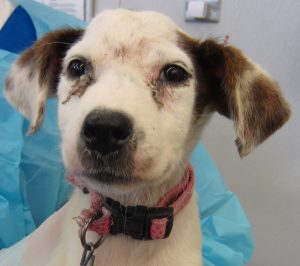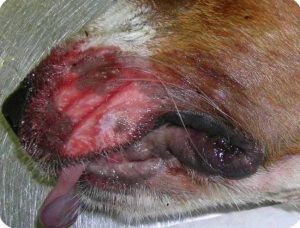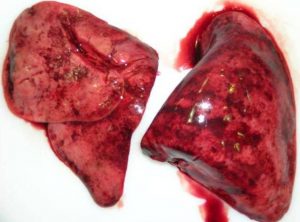Module 4: Healthcare practices for common contagious infectious diseases
Clinical Features of CIRD Pathogens
All of the known canine viral and bacterial respiratory pathogens colonize and damage the mucosal epithelium of the upper respiratory tract to cause similar clinical signs: acute onset of cough, sneezing, nasal and ocular discharge (“kennel cough’). The pathogens also have the propensity to colonize the lower respiratory tract to cause pneumonia.
Bordetella bronchiseptica, CAV2, CPiV, CHV
Bordetella bronchiseptica bacteria typically cause transient disease lasting 7-10 days in adult dogs, but can cause severe, life-threatening pneumonia in puppies. Bordetella can establish chronic infection resulting in intermittent relapses and bacterial shedding for up to 3 months if dogs are not treated with an appropriate antibiotic. Bordetella bacteria are sensitive to doxycyline, minocycline, and Clavamox antibiotics, but are resistant to cephalosporins and trimethoprim-sulfa.
Canine adenovirus type 2 (CAV2) and canine parainfluenza virus (CPiV) commonly infect shelter dogs and are frequent co-pathogens with Bordetella and other respiratory viruses. These two viruses typically cause mild transient disease for 5-7 days and a large number of dogs have subclinical infection.
Primary infection by canine herpesvirus (CHV) may be inapparent or cause mild respiratory signs such as sneezing and clear to mucoid nasal discharge. Cough is generally not a feature of CHV infection, but can occur in dogs that are co-infected by other CIRD pathogens. Unlike the other viral respiratory pathogens, CHV establishes a persistent lifelong infection in the trigeminal ganglion where the virus remains in a latent state unless replication is reactivated by stress. Reactivated infections are generally not associated with clinical signs.
Watch This
The dog in the image and video below (0:23) were in a small municipal shelter that did not give the intranasal vaccine containing modified-live Bordetella and CPiV as recommended by vaccine guidelines for shelter dogs. Many dogs were sneezing with clear to mucoid nasal discharge and coughing. Diagnostic testing by PCR on nasal and pharyngeal swabs revealed co-infections with Bordetella, CPiV, and CAV2.

[No audio commentary in the video below. The dog is coughing and dogs are barking in the background]
CRCoV
Canine respiratory coronavirus (CRCoV) is usually associated with mild transient disease for 5-7 days and is a frequent co-pathogen with other respiratory viruses. Most dogs are susceptible to infection but a large number have subclinical infection. CRCoV is endemic in many high density/high turnover shelters and one of the most common causes of the daily baseline kennel cough cases.
Watch This
The dog in the video (0:16) and image below is in a rural municipal shelter where there are many dogs with kennel cough on a daily basis. The dogs typically start coughing, sneezing, and have mucopurulent nasal discharge within the first week after admission. Dogs receive the DAPP vaccine and the intranasal Bordetella/CPiV kennel cough vaccine on admission according to best practices. Diagnostic testing by PCR on nasal and pharyngeal swabs revealed co-infections with CRCoV and CAV2.
[No audio commentary in the video below. The dog is coughing and dogs are barking in the background]
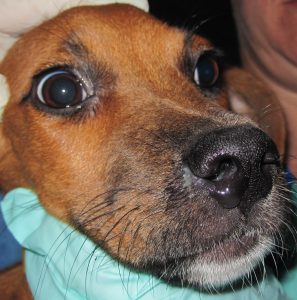
H3N8 CIV, H3N2 CIV, and CnPnV
The two canine influenza viruses (H3N8 CIV and H3N2 CIV) and canine pneumovirus (CnPnV) cause an explosive increase in number of coughing dogs in a short period of time. Since most dogs are susceptible to infection by H3N8 CIV, H3N2 CIV, and CnPnV, these viruses can cause epidemics in shelters where more than 50% of the dogs have constant coughing and purulent nasal discharge for 2-3 weeks. Many dogs infected with any of these viruses can progress to high fever (105F) and pneumonia requiring advanced care in hospital settings. Some dogs die from the pneumonia despite advanced hospital care.
Watch This
The dogs in the image and video below (0:26) are in a municipal shelter in Florida where more than 50% of the 100 dogs developed persistent coughing and nasal discharge over a 3-week period. Most newly admitted dogs developed illness within 5- 7 days of entering the shelter. Diagnostic testing by PCR on nasal and pharyngeal swabs confirmed infection with CnPnV.
Dog with coughing and mucopurulent nasal discharge from CnPnV infection
[No audio commentary in the video below. The dog is coughing and dogs are barking in the background]
CDV
Unlike the other CIRD pathogens, canine distemper virus (CDV) infects epithelial cells in multiple organ systems, including the respiratory tract, gastrointestinal tract, urogenital tract, ocular tract, nervous system, bones and skin. Infection of multiple organ systems confounds recognition and causes frequent misdiagnosis based on clinical signs. The initial clinical signs are typical for kennel cough (sneezing, nasal and ocular discharge, cough), but many infected dogs progress to clinically apparent pneumonia and a wasting syndrome. Other clinical signs can include vomiting and diarrhea similar to parvovirus, dry eye (KCS), photophobia, sterile pustular skin rashes, lameness from bone pain, severe back pain, myoclonus of the head and limbs, and generalized seizures. Some dogs develop hyperkeratosis of the nose and footpads (“hardpad”). CDV infection in puppies can permanently damage the enamel of permanent toothbuds.
Here are some dogs infected with CDV in a large municipal shelter. In the last two months, there has been a progressive increase in the number of pups and adults with kennel cough and pneumonia that is not responding to antibiotic treatment. A couple of puppies developed neurologic signs.
Most dogs had copious purulent nasal discharge with crusting and some also had crusty ocular discharge.
- CDV-infected dog with crusty nose
- Another CDV-infected dog with crusty nose
- A third CDV-infected dog with crusty nose and nasal discharge
- A fourth CDV-infected dog with ocular discharge
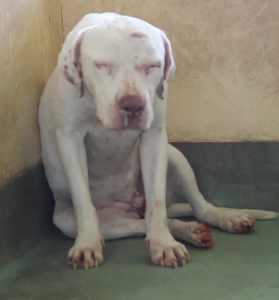
Watch This
Watch This
Several dogs had pneumonia as evidenced by tachypnea and dyspnea as shown in the video below (0:12).
[No audio commentary in the video below. The dog has a rapid respiratory rate with increased effort and dogs are barking in the background]
Watch This
Watch This
Strep zoo
Streptococcus zooepidemicus (Strep zoo) is a Lancefield group C bacterium recently identified as a cause of fatal hemorrhagic pneumonia in shelter dogs. Dogs present initially with cough and nasal discharge that rapidly progresses to respiratory distress, bleeding from the nose and mouth, and death within hours. Dogs with primary infections by CDV, CIV, or CnPnV are at highest risk for co-infection with Strep zoo bacteria.
Watch This
Many dogs that appear fine at the end of the day are found dead in their run the next morning with blood coming from the nose and mouth. Death is due to hemorrhagic pneumonia and bleeding in the chest cavity.
- Dog found dead in its run
- Fatal fulminant hemorrhagic pneumonia caused by Strep zoo infection
Dogs infected with Strep zoo can survive if treated quickly with antibiotics such as penicillin, Clavamox, cephalexin, Simplicef, or Convenia, but not doxycycline or fluoroquinolones such as Baytril.
Mycoplasma cynos
The ability of Mycoplasma cynos (M cynos) to initiate primary respiratory infection is unclear. These bacteria are part of the commensal flora in the upper respiratory tract, and are frequently identified in both dogs that are healthy and those with respiratory infections. Trachea and lung tissue damage from respiratory viral infections may promote over-colonization by M cynos, contributing to disease. Mycoplasma are sensitive to antibiotics such as doxycycline, minocycline, azithromycin, clindamycin, and fluoroquinolones.
Test Your Knowledge

